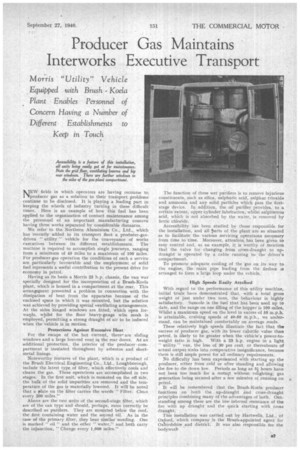Producer Gas Maintains Interworks Executive Transport
Page 25

If you've noticed an error in this article please click here to report it so we can fix it.
Morris "Utility" Vehicle .Equipped with Brush Koela Plant Enables Personnel of Concern Having a Number of Different Establishments to
Keep in Touch
NEW fields in which operators are having recourse to, producer gas as a solution to their transport problems continue to be disclosed. It is playing a leading part in keeping the wheels of industry turning in these difficult times. Here is an example of how this fuel has been applied to the organization of contact maintenance among the personnel of an important manufacturing concern having three works separated by considerable distances.
We refer to the Northern Aluminium Co., Ltd., which has 'recently added to its transport fleet a producer-gasdriven " utility" vehicle for the conveyance of works executives between its different establishments. The machine is required to accomplish single journeys, ranging from a minimum of 95 miles to a maximum of 100 miles. For producer-gas operation the conditions of such a service are particularly favourable and the employment of solid fuel represents a useful contribution to the present drive for economy in petrol.
Having as its basis a Morris 25 h.p. chassis, the van was specially designed for the incorporation of a Brush-Koela plant, which is housed in a compartment at the rear. This arrangeanent presented a problem in connection with the dissipation of heat from the apparatus because of the enclosed space in which it was mounted, but the solution was achieved by providing special ventilating arrangements. At the sides hinged windows are fitted, which open forwards, whilst for the floor heavy-gauge wire mesh is employed, permitting a strong draught of air to be induced when the vehicle is in motion.
Protections Against Excessive Heat For the escape of the hot current, there are sliding windows and a large louvred vent in the rear doors. M an additional protection, the interior of the producer-compartment is insulated throughout by asbestos and sheetmetal linings. , Noteworthy features of the plant, which is a product of the Brush Electrical Engineering Co., Ltd., Loughborough, include the latest type of filter, which effectively cools and cleans the gas. These operations are accomplished in two stages. In the first unit, which is mounted on the off side, the bulk of the solid impurities are removed and the temperature of the gas is materially lowered. It will be noted that a plate on the filter carries the words " Filter. Clean every 200 miles."
Above are the two units 0.1 the second-stage filter, which are of the can type and should, perhaps, more correctly be described as purifiers. They are mounted below the roof, the first containing water and the second oil. As in the case of the primary filter, they bear similar wording. One is marked " oil " and the other " water," and both carry the injunction, "'Change every 1,000 miles." The function of these wet purifiers is to remove injurious constituents, such as silica, sulphuric acid, sulphur trioxide and ammonia and any solid particles which pass the firststage device. In addition, the oil purifier provides, to a certain extent, upper cylinder, lubrication, whilst sulphurous acid, which is not absorbed by the water, is removed by ferric chloride.
Accessibility has been studied by those responsible for the installation, and all tarts of the plant are so situated as to facilitate the various servicing operations necessary from time to time. Moreover, attention has been given to easy control and, as an example, it is worthy of mention that the valve for changing from cross-draught to updraught is operated by a cable running to the driver's compartment.
To promote adequate cooling of the 'gas on its way to the engine, the main. pipe leading from the firebox is arranged to form a large loop under the vehicle.
High Speeds Easily Attalhed With regard to the performance of this utility machine, initial trials have demonstrated that, with a total gross weight of just under two tons, the behaviour is highly satisfactory. Suncole is the fuel that has been used up to date, and the range on one filling of the hopper is 100 miles. Whilst a maximum speed on the level in excess of 55 m.p.h, is attainable, cruising speeds of 40-50 m.p.h., we understand, can be maintained comfortably on average roads.
These relatively high speeds illustrate the fact that the success of producer gas, with its lower calorific value than petrol, is likely to be greater when the vehicle's power-to weight ratio is high. With a 25 h.p. engine in a light " utility. " van, the loss of 30 per cent, or thereabouts of actual output sinks into ,comparative insignificance, because there is still ample power for all ordinary requirements.
No difficulty has been experienced with starting up the producer, either from cold or after standing and allowing the fire to die down low. Periods as long as 3i hours have not been too much for a restart without relighting, gas generation being secured after a few minutes of running on petrol.
It will be remembered that the Brush-Koela producer functions on both the up-draught and cross-draught principles combining many of the advantaget of both. Outstanding among these are the low internal resistance of the fire with up draught and the quick starting with cross draught.
This installation was carried out by Hartwells, Ltd., of Oxford, which company is the Brush-appointed agent for Ox.fordshire and district. It was also responsible for the bodywork




















































